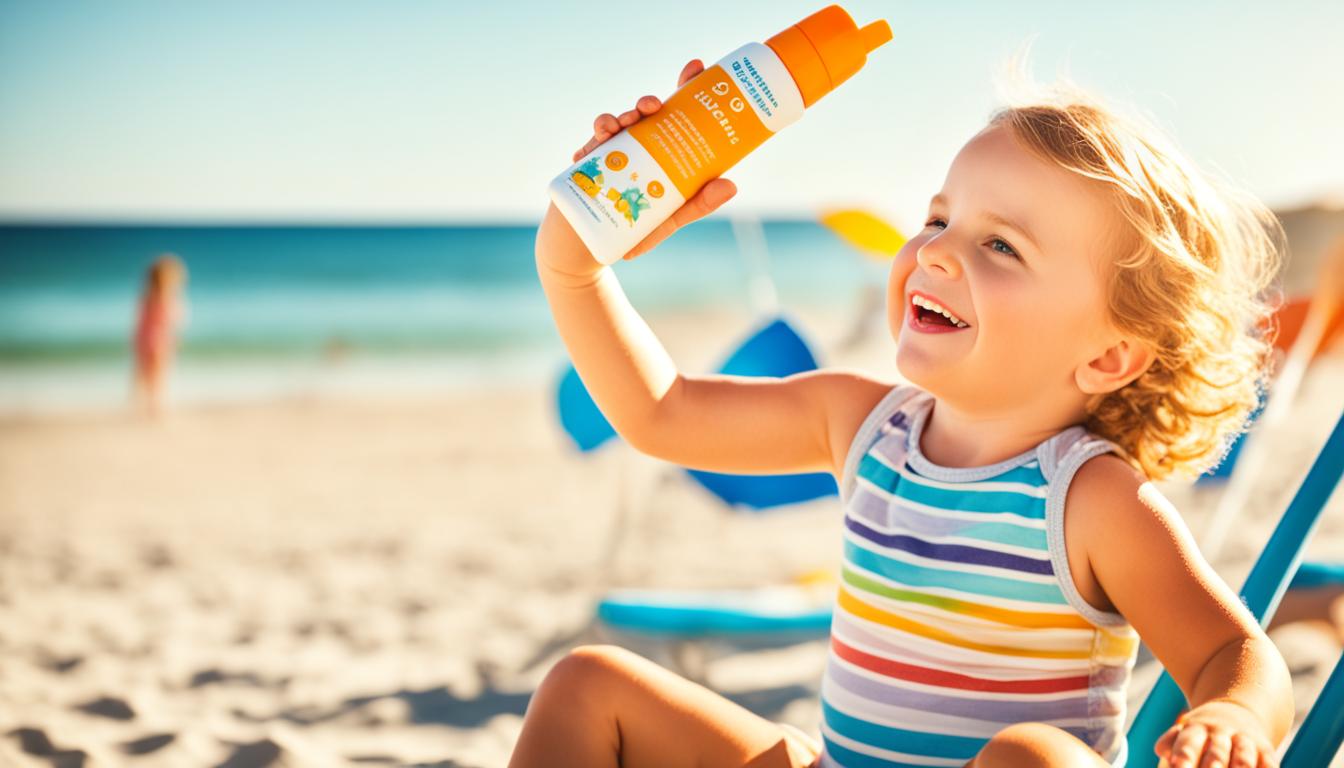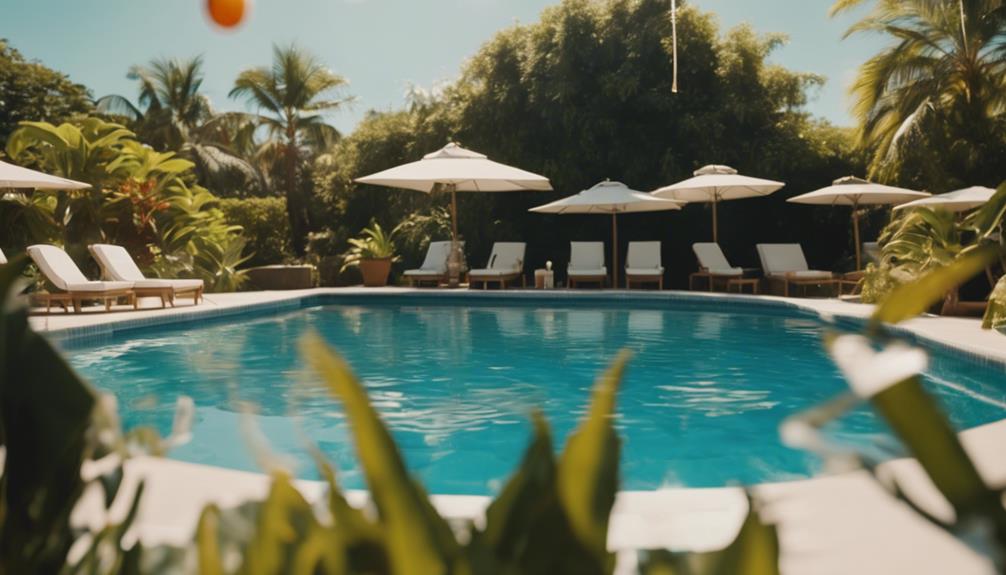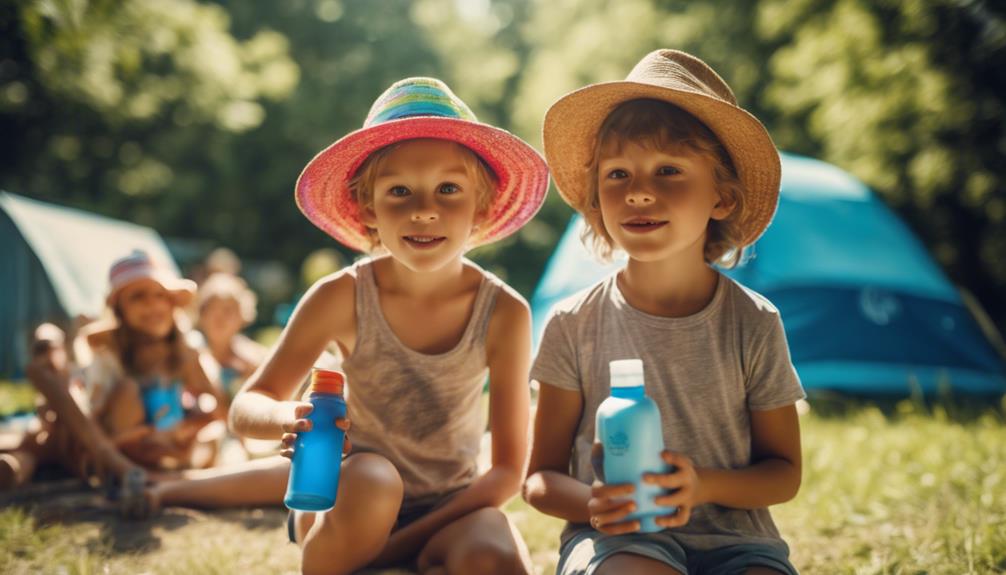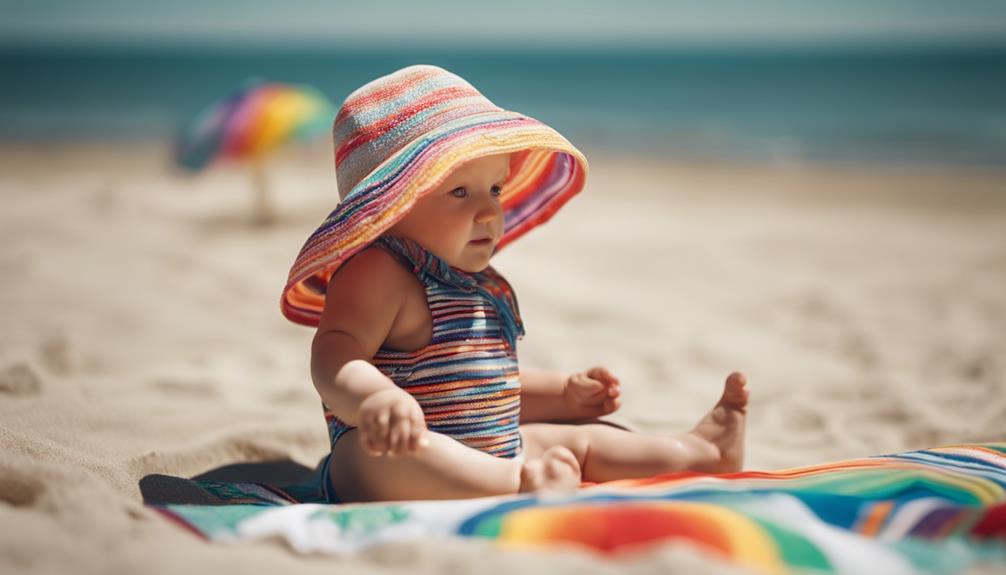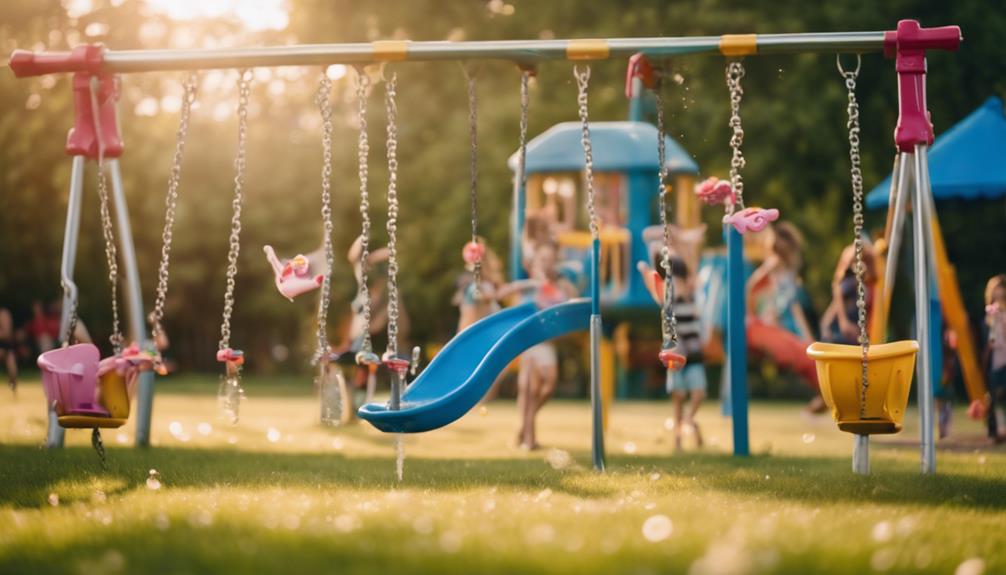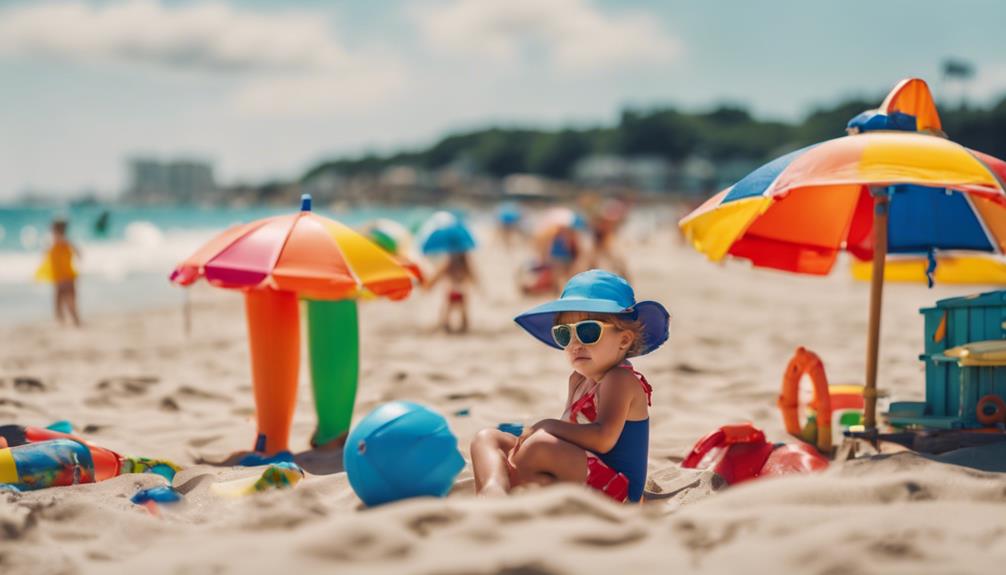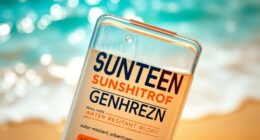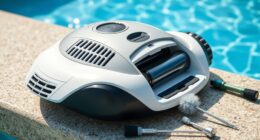Did you know kids get about 23% of their lifetime sun exposure before they’re 18? This fact highlights the need for good sun protection from an early age1. Kids’ skin is very sensitive, making it super important to pick the right sunscreen. Dermatologists have found that more than five sunburns in childhood can really increase the risk of skin cancer later1.
That’s why using special sunscreens for kids, with safe ingredients and strong SPF, is key. This guide will share the best picks to protect your kids. They can enjoy the sun safely with the right sunscreen.
Key Takeaways
- Children get 23% of their lifetime sun exposure before age 18.
- More than five sunburns can increase melanoma risk.
- SPF 40 or higher is recommended for effective UV protection.
- Choose non-toxic ingredients like zinc oxide for sensitive skin.
- Water-resistant formulations are vital for active kids.
- Fragrance-free options help avoid allergic reactions.
- Proper application includes applying sunscreen 15 minutes before sun exposure.
Introduction to Child Sun Protection
Every parent knows keeping kids safe from the sun is vital. Children’s skin is thinner and more sensitive than adults. This makes them more prone to sunburn and long-term harm. The American Academy of Dermatology says all kids need sunscreen with at least SPF 3023.
Choosing the right sunscreen is crucial. You could go for mineral ones with zinc oxide or titanium dioxide. These create a barrier on the skin against the sun2. Chemical sunscreens, however, soak up UV rays and take 15-30 minutes to start working2. If your child is playing in water, pick a sunscreen that is water-resistant for 40-80 minutes2.
Don’t forget, clothes are also a strong protection against the sun. For babies under six months, keep them out of direct sunlight4. Starting sun safety habits early can lower the risk of skin cancer and early aging4.
Why Sun Protection is Crucial for Children
It’s crucial to understand why children need protection from the sun. Their skin is very sensitive and sun damage can be severe. Without proper sunblock, kids risk immediate pain and future skin problems. Protecting your child is key to prevent dangers like child sunburn risks.
Understanding the Risks of Sunburn
Sunburns hurt a lot right away and can lead to big health problems, like skin cancer, down the line. Kids who get burned by the sun are much more likely to get skin cancer when they grow up. A study shows a clear link between sunburns in young people and skin cancer later5. Put sunscreen with SPF 30 or more on all children to keep them safe6. It’s important to put more on if they’re outside for a while.
Cumulative Sun Damage Before Age 18
A lot of the sun’s damage happens before someone turns 187. That’s why wearing sunscreen from a young age is urgent. Even on cloudy days, harmful UV rays can still reach us7. Teaching kids to use sunscreen early on lowers their risk of skin damage. This keeps their skin healthier as they grow older.

Factors to Consider When Choosing Sunscreen for Your Lloyd
Choosing the right sunscreen for kids is crucial. Look for products that provide strong protection. This ensures their skin stays safe.
SPF Requirements for Maximum Protection
Dermatologists suggest sunscreens with at least SPF 30 for kids. This blocks about 97% of UVB rays. SPF 50 blocks roughly 98% of these rays89. It’s key to protect them, as kids are more at risk of skin cancer with too much sun8.
Importance of Non-Toxic Ingredients
Choose sunscreens with zinc oxide or titanium dioxide. They are gentle on the skin. Perfect for those with sensitive skin8. Stay away from oxybenzone and parabens. These can harm young skin9.
Water Resistance for Active Kids
Active kids need waterproof sunscreen. Check for products that stay on in water. Mineral-based ones might need more frequent application during water play9.
Fragrance-Free Formulations for Sensitive Skin
Pick sunscreens without fragrances to avoid allergic reactions. This is important for kids with sensitive skin10. Apply it 15 minutes before sun exposure. Remember to reapply it every two hours, or after swimming or sweating10.

Child-Specific Sunscreen Recommendations
Choosing the right sunscreen for your kids is very important. It helps protect them from harmful UV rays. Mineral sunscreens are often the best for kids. They have natural ingredients and protect well against UV rays.
Mineral Sunscreen Sticks
Mineral sunscreen sticks are easy to use on the move. Here are top picks you might want to check out:
- Baby Bum SPF 50: A gentle formula with zinc oxide, great for sensitive skin.
- Blue Lizard Baby Mineral Sunscreen Stick: Offers SPF 50 protection and is easy to apply on kids.
Whole-Body Mineral Sunscreens
For protecting the whole body, pick mineral sunscreen lotions meant for kids. Below are highly recommended ones:
- Blue Lizard Kids Mineral Sunscreen SPF 50: It offers broad-spectrum protection, is water-resistant, and good for sensitive skin.
- Babyganics Mineral Sunscreen Lotion SPF 50+: Protects while being mild and not causing irritation.

| Product | SPF Level | Key Features |
|---|---|---|
| Baby Bum SPF 50 | 50 | Contains zinc oxide, gentle on skin |
| Blue Lizard Baby Mineral Sunscreen Stick | 50 | Easy application, high protection |
| Blue Lizard Kids Mineral Sunscreen SPF 50 | 50 | Water-resistant, broad-spectrum protection |
| Babyganics Mineral Sunscreen Lotion SPF 50+ | 50+ | Non-irritating, suitable for sensitive skin |
Make sure any sunscreen you choose follows guidelines for children’s sun protection. Mineral sunscreens are preferred for kids as they block UV rays well and are safe1112.
Top Picks for Child-Specific Sunscreen
Finding the right sunscreen for your child is very important. It keeps their skin safe from the sun’s harmful rays. Here’s a list of excellent sunscreens that are both safe and effective.
Blue Lizard Kids Mineral Sunscreen SPF 50
Many parents trust Blue Lizard. It’s made with zinc oxide to protect without irritating the skin. The bottle changes color in the sun to remind you to use it. This makes it a favorite13. Skin doctors recommend this sunscreen because it’s gentle on kids13.
Aveeno Kids Continuous Protection Mineral Sunscreen SPF 50
Aveeno’s sunscreen is great for sensitive skin. It uses natural zinc oxide to block the sun14. It’s not oily, has no scent, and calms the skin. Parents prefer it for these qualities13.
Neutrogena Kids Sheer Zinc Sunscreen Stick SPF 50
This Neutrogena Stick is easy to apply. The stick means quick application and complete coverage. It’s allergy-safe and a top pick for protecting kids13.

Tips for Proper Sunscreen Application
Putting on sunscreen right is key to keeping your child safe from the sun. Start 15 to 30 minutes before they go outside. Make sure to cover all areas that the sun can hit.
When to Apply Sunscreen
Put on sunscreen before your child goes outside to keep them protected right away. The FDA says to do this 15 to 30 minutes before sun exposure15. Also, don’t forget to apply it from 10 a.m. to 2 p.m. when the sun is strongest16.
Frequency of Reapplication
Sunscreen needs to go on again every one to two hours, more if swimming or sweating15. Even water-resistant types need reapplying every 40 to 80 minutes for the best protection15. Always bring enough for a whole day at the beach, about 2 to 4 ounces15.
Areas Often Missed During Application
Some spots often get missed when applying sunscreen. Areas like the ears, back of the neck, and shoulders are crucial16. Regular checks help keep your child fully protected from sunburn and skin damage.

Safe Sun Practices Beyond Sunscreen
Your child’s sun safety is about more than sunscreen. It’s vital to add other sun protection methods. Clothes and accessories that protect from the sun boost safety from UV rays a lot.
Protective Clothing for Children
Protective clothes for kids need to fit well and be made of the right material. Clothes like long sleeve shirts and pants, made from fabrics that are tightly woven, block more UV rays. Cotton is a good choice because it’s cool and shields skin from the sun.
Remember, a wet T-shirt doesn’t guard against the sun as much as a dry one. Also, kids can get sun damage in just 11 to 23 minutes if they’re not protected. That’s why wearing the right clothes at the right time is key17.
Importance of Hats and Sunglasses
Hats and sunglasses are also critical for sun protection. Hats with wide brims cover the face, ears, and neck from the sun. Sunglasses that block UV rays protect the eyes.
Very few play areas are fully shaded during peak sun hours. Adding hats and sunglasses to your child’s outdoor routine can greatly lower their sun damage risk. This helps them learn good sun safety habits early on17.

Understanding Different Sunscreen Types
It’s crucial to know about the different sunscreens for your child’s skin. There are two main kinds: mineral and chemical sunscreens. Each has its benefits, whether it’s creams, lotions, or powder forms.
Mineral vs. Chemical Sunscreens
Mineral sunscreens sit on top of the skin. They block UV rays using zinc oxide or titanium dioxide. They’re great for kids with sensitive skin. Chemical sunscreens soak up UV rays and change them into heat, released from the skin. They may feel lighter but might not suit very sensitive skin. So, for little ones, mineral sunscreens are often the better choice1819.
The Benefits of Creams and Lotions
Creams and lotions are easy to use on children. They stick well to the skin because they’re thicker. They should have an SPF of at least 30. This protects from UVA and UVB rays, crucial for kids’ thinner skin1820.
Using Powder Formulas
Powder sunscreens are good for quick touch-ups outside. They’re less messy than creams. But, they might not cover as well as lotions do. So, you have to watch how they’re used19
| Sunblock Type | Application Style | Best For |
|---|---|---|
| Mineral Sunscreens | Apply to skin surface | Sensitive skin, infants |
| Chemical Sunscreens | Absorbs UV rays | Active teens, adults |
| Creams and Lotions | Thick application | Comprehensive coverage |
| Powder Formulas | Dusting on skin | Easy reapplication |
Knowing the different kinds of sunscreens helps you choose the best for your child’s skin181920.
Skin Sensitivity and Choosing the Right Sunscreen
When picking sunscreen for kids with sensitive skin or eczema, finding one without allergens and irritants is key. Look for products labeled as hypoallergenic. They are less likely to cause reactions on delicate skin. It’s also important to choose sunscreens made for sensitive skin that don’t have harsh chemicals, fragrances, or preservatives.
Identifying Allergens and Irritants
Fragrances, parabens, and some chemical sunblocks can irritate skin. For kids with sensitive skin, sunscreens with natural ingredients are better. Also, mineral-based sunscreens with zinc oxide and titanium dioxide are safer. They reflect UV rays instead of absorbing them, which is good for sensitive skin21.
Choosing Products for Eczema-Prone Skin
Mineral sunscreens are the best choice for eczema-prone skin. They’re less likely to trigger skin reactions and protect well without worsening skin problems. Apply children’s sunscreen 25 minutes before going outside and reapply every two hours, or after swimming or sweating21. It’s important to use sunblocks with simple, gentle ingredients. This helps keep your child safe and reduces the chance of skin irritation.

Child-Specific Sunscreen and Skin Type Considerations
Choosing the right sunscreen for your child means knowing their skin type. For kids with oily or dry skin, this is critical. It helps you pick the sunscreen that suits them best.
Best Options for Oily Skin
For the young ones with oily skin, pick sunscreens labeled as non-comedogenic. These don’t clog pores but protect well from the sun. Here’s what you might consider:
- Neutrogena Clear Face Liquid Lotion SPF 30
- Coppertore Oil-Free SPF 50
- Blue Lizard Sensitive Mineral Sunscreen SPF 30
Choosing Sunscreen for Dry Skin
If your child has dry skin, opt for a thick cream with moisturizers. It keeps the skin hydrated and protected. Here are a few good options:
- Aveeno Baby Continuous Protection Sensitive Skin Broad Spectrum SPF 50
- Badger Baby Broad Spectrum SPF 30 Sunscreen
- Babyganics Mineral-Based Sunscreen Lotion SPF 50

| Sunscreen Type | Skin Type | SPF | Key Ingredient |
|---|---|---|---|
| Neutrogena Clear Face Liquid Lotion | Oily | 30 | Oil-Free |
| Coppertone Oil-Free | Oily | 50 | Lightweight formula |
| Aveeno Baby Continuous Protection | Dry | 50 | Natural ingredients |
| Badger Baby Broad Spectrum | Dry | 30 | Organic ingredients |
Knowing your child’s skin type is key to good sun protection. Always go for a dry skin sunscreen recommendation or a sunscreen for oily skin kids that suits their needs. This ensures they’re safe in the sun222324.
Recent Innovations in Child-Specific Sunscreen
Child-specific sunscreens are getting better and safer. Innovations now teach kids about staying safe in the sun. They also make things easier for parents. A cool new feature is the smart cap. It changes colors to warn about UV rays. This helps everyone remember to use sunscreen.
Smart Cap Technology in Sunscreens
Smart cap technology is a big deal for keeping safe in the sun. It changes color in UV rays to remind us to put on sunscreen. This helps kids and adults stay protected.
Travel-Friendly Formats
Travel-friendly sunscreens are becoming a hit with families. Products like sunscreen sticks and compact bottles are great for quick applications. Perfect for beach days or outdoor fun. These designs make life easier for everyone.
Consumers love portable sunscreen options. They’re looking for sprays and sticks that are simple to use. This matches today’s busy lifestyles. People want products that keep up with their fast pace25.

Conclusion
Choosing the right sunscreen for kids is key to keeping them safe outside. Kids who get bad sunburns may have a higher chance of skin cancer later. So, it’s important to pick sunscreen with at least SPF 30. This protects against UVA and UVB rays26.
Some sunscreens are better for kids because they don’t have harsh chemicals27. Luckily, about 93% of sunscreens have SPF 30 or more. So, parents have many safe options for their children.
Remember, it’s vital to apply and reapply sunscreen every two hours. Also, do it again after your child swims or sweats26. This helps keep your kids’ skin safe while they have fun outside.
